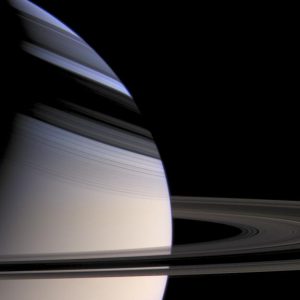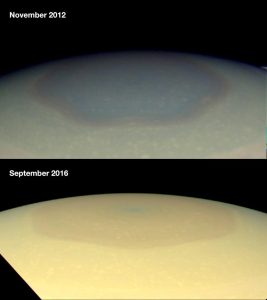27 December 2018
Rings make Saturn shadier, bluer and less hazy in winter
Posted by llester
Saturn’s rings act like Venetian blinds that block sunlight for the hemisphere that’s tilted farther away from the Sun, limiting winter sunlight. This cuts down on the planet’s haze and golden glow.
By Erika K. Carlson

Saturn’s rings shade the winter hemisphere, keeping sunlight from making the hazes that give most of the planet its golden color. The clearer atmosphere is blue thanks to the same light scattering phenomenon at work in Earth’s skies.
Credit: NASA/JPL/Space Science Institute
On Saturn, changing seasons can mean changes in the haziness — and color — of the skies.
In the 13 years the Cassini spacecraft orbited Saturn, from 2004 to 2017, scientists noticed the atmosphere in the planet’s northern hemisphere turned from blue-tinted to gold or even salmon. The stark color shift came from changes in the amount of sunlight-triggered haze in Saturn’s atmosphere, according to new research.
“I think everyone was kind of surprised by why the atmosphere was blue,” said planetary scientist Scott Edgington, who is the deputy project scientist of the Cassini mission. Edgington presented the findings in a poster session last week at the 2018 American Geophysical Union Fall Meeting in Washington, D.C.
Scientists are striving to pin down all of the light sources that shine on Saturn and understand how the light interacts chemically with Saturn’s atmosphere. Answering these questions may help researchers better understand differences in the atmospheres of the Solar System’s gas giants Jupiter and Saturn, and the ice giants Uranus and Neptune.
Jupiter and Saturn have hazes that give them a golden color, while Uranus and Neptune have clearer atmospheres like Earth’s blue skies on a clear day. But as the researchers saw in Cassini images, Saturn wasn’t always covered in golden haze.
“Of course, people were scratching their heads,” Edgington said. “Why isn’t it hazy everywhere, just like Jupiter?”
In Saturn’s case, particularly limited sunlight in the winter seems to let the planet’s atmosphere recover from bouts of haziness. The reason for the extra sun protection? The planet’s massive rings.
The main driver of Saturn’s seasons is the planet’s tilt, just like on Earth. Earth is tilted so that the Northern Hemisphere faces the sun most directly in June and the Southern Hemisphere sees the sun face-on in December. In December, the Northern Hemisphere experiences long winter nights while the Southern Hemisphere enjoys its long summer days.
The same effect happens on Saturn, which is tilted about as much as Earth is. But Saturn also has an expansive ring system that blocks sunlight for the hemisphere tilted away from the sun, making winters even less sunny on the gas giant.
The planet’s changing sun exposure is responsible for the seasonal swings in its atmosphere’s haziness, Edgington said.

Saturn’s north pole changed from blue-tinted in 2012 to gold in 2016 as the northern hemisphere’s season turned from winter.
Credit: NASA/JPL-Caltech/Space Science Institute/Hampton University
Sunlight breaks apart methane gas molecules, which are a small but significant fraction of Saturn’s atmosphere. Methane’s breakup creates other molecules like ethane and acetylene, which trigger a complex web of chemical reactions that eventually make haze.
When one hemisphere of Saturn is enjoying a shaded winter, the haze-making process slows down. Existing haze particles clump to form heavier grains and sink further into the planet’s atmosphere and out of sight without new batches of haze to replace them.
Thanks to that, Saturnian summers tend to have hazy, golden skies, while winters have clearer, bluer skies.
“It seems like there’s a direct connection between what we see and what the chemistry tells us should happen,” Edgington said.
The researchers will continue to study Cassini’s data of Saturn’s atmosphere. They still need to incorporate the last few years of Cassini’s data into this project, Edgington said.
One aspect of the project Edgington seemed especially excited about was figuring out how light reflecting off Saturn’s rings contributes to the planet’s sun exposure. Because Saturn’s rings extend far beyond the planet’s main body, sunlight can bounce off parts of the far side of the rings and onto the planet’s dark side.
“Even the dark side of the planet really isn’t that dark,” Edgington said.
— Erika K. Carlson is a master’s student in the science communication program at the University of California, Santa Cruz. See more of her work at erikak.ca or follow her on Twitter @erikakcarlson.










 GeoSpace is a blog on Earth and space science, managed by AGU’s Public Information staff. The blog features posts by AGU writers and guest contributors on all sorts of relevant science topics, but with a focus on new research and geo and space sciences-related stories that are currently in the news.
GeoSpace is a blog on Earth and space science, managed by AGU’s Public Information staff. The blog features posts by AGU writers and guest contributors on all sorts of relevant science topics, but with a focus on new research and geo and space sciences-related stories that are currently in the news.